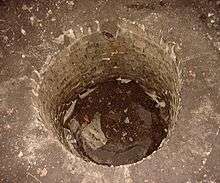Dry well

A dry well or soak pit is an underground structure that disposes of unwanted water, most commonly stormwater runoff, by dissipating it into the ground, where it merges with the local groundwater. Often called a soakaway in the UK, a soakwell in Australia[1] and known as a soak pit in India. A soak pit is a covered, porous-walled chamber that allows water to slowly soak into the ground.
A covered dry well that disposes of sewage is called a cesspool, while an open pit that receives storm water and dissipates it into the ground is called an infiltration basin (recharge basin) or rain garden and operates similar to a septic drain field (sewage farm). A French drain can resemble a horizontal dry well that is not covered.
A dry well is a passive structure. Water flows through it under the influence of gravity. A dry well receives water from one or more entry pipes or channels at its top and discharges the same water through a number of small exit openings distributed over a larger surface area in the side(s) and bottom of the dry well. When a dry well is above the water table, most of its internal volume will contain air. Such a dry well can accept an initial inrush of water very quickly, until the air is displaced. After that, the dry well can only accept water as fast as it can dissipate water. Some dry wells deliberately incorporate a large storage capacity, so that they can accept a large amount of water very quickly and then dissipate it gradually over time, a method that is compatible with the intermittent nature of rainfall. A dry well maintains the connection between its inflow and outflow openings by resisting collapse and resisting clogging.
Simple dry wells consist of a pit filled with gravel, riprap, rubble, or other debris. Such pits resist collapse, but do not have much storage capacity because their interior volume is mostly filled by stone. A more advanced dry well defines a large interior storage volume by a reinforced concrete cylinder with perforated sides and bottom. These dry wells are usually buried completely, so that they do not take up any land area. The dry wells for a parking lot's storm drains are usually buried below the same parking lot.
Polypropylene Dry Wells or Soakwells
A modern innovation in the stormwater industry is using polypropylene material to create a soakwell or dry well structure. Polypropylene offers numerous benefits over their concrete or brick and mortar counterparts. Some of the benefits of Polypropylene Soakwells are:
- Polypropylene Soakwells are made from Environmentally selected Recycled Polypropylene
- Polypropylene Soakwells allow Stormwater Management onsite
- Polypropylene Stormwater tanks Recharge Groundwater Table via Filtration and Dispersion
- Reduces the effect of downstream flooding • Polypropylene Soakwells are configurable with allowing intelligent site space usage
- Allows for minimum site disruption, with above ground available for alternate use
- Polypropylene soakwells are a Modular structure providing design flexibility
- Polypropylene Soakwells are rated for Heavy Duty load carrying capacity up to 40t/sqm depending on design specifications
- Polypropylene soakwells boast 95% High void surface ratio
- Light Weight reducing the need for machinery[2]

See also
References
- ↑ Davis, Jacques. "Environmentalist". Perth Soakwells Pty Ltd. Retrieved 13 March 2016.
- ↑ Davis, Jacques. "Environmentalist". Retrieved 13 March 2016.
- DRYWELLS, Environmental Services, City of Portland, OR
- New Jersey Stormwater - Best Management Practices Manual, Chapter 9.3 Standard for Dry Wells, February 2004
- Philadelphia Watershed, Dry Well, Philadelphia Water Department
- Water Quality Division: Permits: Drywell Program, Arizona Department of Environmental Water Quality
External links
- Non-residential drywells are regulated in the U.S. to protect drinking water sources - US EPA
- Photos of a reinforced concrete drywell installation
- Photos of Australian Soakwell Installation